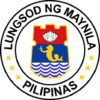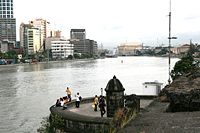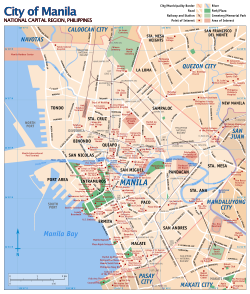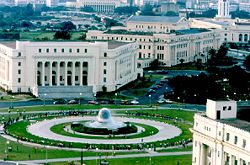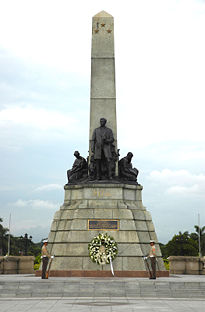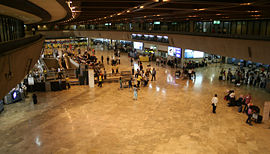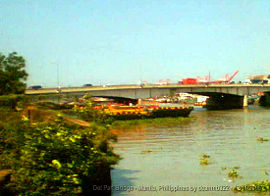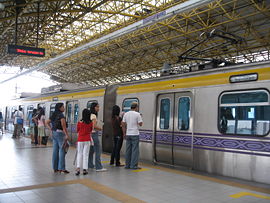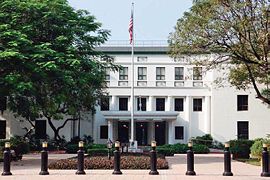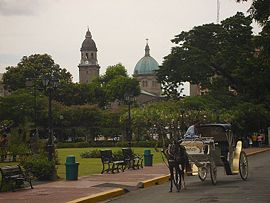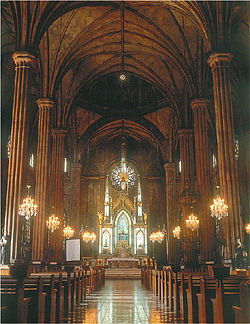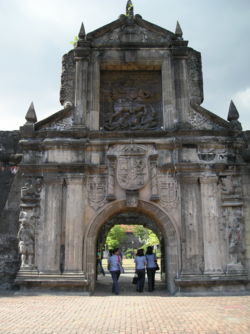Manila
2008/9 Schools Wikipedia Selection. Related subjects: Asia; Asian Cities
| City of Manila Lungsod ng Maynila |
|||
| The Manila Bay skyline | |||
|
|||
| Nickname: "Perla del Oriente (Pearl of the Orient)", "The City of Our Affections", "City by the Bay", "La Insigne y Siemple Leal Ciudad (Distinguished and Ever Loyal City)" | |||
| Motto: Linisin, Ikarangal ang Maynila | |||
| Map of Metro Manila showing the location of Manila Coordinates: 14°35' N 121° E | |||
| Country | Philippines | ||
|---|---|---|---|
| Region | National Capital Region | ||
| Districts | 1st to 6th districts of Manila | ||
| Barangays | 897 | ||
| Incorporated (city) | June 10, 1574 | ||
| Government | |||
| - Mayor | Alfredo Lim (2007-2010; GO) | ||
| - Vice Mayor | Isko Moreno ( AM/ PDP-Laban/ GO) | ||
| Area | |||
| - Total | 38.55 km² (14.9 sq mi) | ||
| Elevation | 16.0 m (52 ft) | ||
| Population (2007) | |||
| - Total | 1,660,714 | ||
| - Density | 43,079/km² (111,574.1/sq mi) | ||
| Time zone | PST ( UTC+8) | ||
| Zip code | 0900 to 1096 | ||
| Area code(s) | 2 | ||
| Website: www.manila.gov.ph | |||
The City of Manila ( Filipino: Lungsod ng Maynila or Siyudad ng Maynila), or simply Manila, is the capital of the Philippines and one of the cities that make up the greater metropolitan area of Metro Manila. Manila is the centre of government in the country and one of the central hubs of a thriving metropolitan area home to over 14 million people. It is located on the shores of Manila Bay just west of the geographical centre of Metro Manila, also known as the National Capital Region (NCR), which lies on an isthmus between Manila Bay and Laguna de Bay in southern Luzon. The city is one of 17 cities and municipalities which form the metropolitan area.
Manila is the second most populous city proper in the Philippines, with more than 1.6 million inhabitants. Only nearby Quezon City, the country's former capital, is more populous. The metropolitan area is the second most populous in Southeast Asia. Manila is currently included in the roster of global cities of the world.
Well into the 13th century, the city consisted of a fortified settlement and trading quarter at the bay of the Pasig River, on top of previous older towns. The official name of the city under its Malay aristocracy was Seludong/Selurung, which was the same name given for the general region of southwestern Luzon at that time, suggesting that it was the capital of this territory (see Ancient Tondo). However, the city became well-known by the local name given to the city by its Tagalog inhabitants: Maynilad. The name is from the phrase may nilad, Tagalog for "there is nilad," in reference to the flowering mangrove plant that grew on the marshy shores of the bay, used to produce soap for regional trade. It is from the name Maynilad that the city of Manila derives its modern name.
Manila became the seat of the colonial government of Spain when it controlled the Philippine Islands for over three centuries from 1565 to 1898. Beginning in 1898, the United States occupied and controlled the city and the Philippine archipelago until 1946. During World War II, much of the city was destroyed. The Metropolitan Manila region was enacted as an independent entity in 1975.
Manila has been classified as a "Gamma" global city by the Globalization and World Cities Study Group and Network.
Geography
Manila lies at the mouth of the Pasig River on the eastern shores of Manila Bay, which is on the western side of Luzon. It lies about 950 kilometers southeast of Hong Kong and 2,400 kilometers northeast of Singapore. The river bisects the city in the middle. Almost all of the city sits on top of centuries of prehistoric alluvial deposits built by the waters of the Pasig River and on some land reclaimed from Manila Bay. The layout of the city was haphazardly planned during Spanish Era as a set of communities surrounding the original Spanish Era walled city of Manila, called Intramuros. Intramuros is one of the oldest walled cities in the far east. During the American Period, some semblance of city planning using the architectural designs and master plans by Daniel Burnham was done on the portions of the city south of the Pasig River. Burnham, the noted American city planner and architect, was famed for his plans and designs of Chicago, Cleveland (the Group Plan), San Francisco, Washington, DC (the McMillan Plan), and Baguio City, details of which appear in The Chicago Plan publication of 1909.
Manila is bordered by several municipalities and cities in Metro Manila: Navotas and Caloocan City to the north, Quezon City to the northeast, San Juan and Mandaluyong City to the east, Makati City to the southeast, and Pasay City to the south.
Government
City seal
The Seal of Maynila depicts the words Lungsod ng Maynila and Pilipinas, Filipino for City of Manila and Philippines, in a circle around a shield. The circle also contains six yellow stars representing the city's six congressional districts. The shield, in the shape of pre-colonial people's shield, depicts the city's nickname Pearl of the Orient on top; a sea lion in the middle, in reference to the city's Spanish influences; and the waves of the Pasig River and Manila Bay in the bottom portion. The colors of the seal mirror that of the Flag of the Philippines.
Districts
The city is divided into sixteen (16) districts. Only one district was not an original town - Port Area. Eight (8) districts are located north of the Pasig River and eight (8) are in the south. San Andres Bukid was previously part of Santa Ana, while Santa Mesa was once a part of Sampaloc. These districts should not be confused with the six congressional districts of Manila.
| District | Barangays | Population (2007 census) |
Area ( has.) |
Pop. density (per km²) |
|---|---|---|---|---|
| Binondo | 10 | 12,100 | 66.11 | 18,304.1 |
| Ermita | 13 | 6,205 | 158.91 | 3,904.8 |
| Intramuros | 5 | 5,015 | 67.26 | 7,455.7 |
| Malate | 57 | 78,132 | 259.58 | 30,099.8 |
| Paco | 43 | 69,300 | 278.69 | 24,866.7 |
| Pandacan | 38 | 76,134 | 166.00 | 45,862.9 |
| Port Area | 5 | 48,684 | 315.28 | 15,441.4 |
| Quiapo | 16 | 23,138 | 84.69 | 27,322.0 |
| Sampaloc | 192 | 255,613 | 513.71 | 49,758.5 |
| San Andres | 65 | 116,585 | 168.02 | 69,386.2 |
| San Miguel | 12 | 16,115 | 91.37 | 17,636.9 |
| San Nicolas | 15 | 43,225 | 163.85 | 26,380.5 |
| Santa Ana | 34 | 62,184 | 169.42 | 36,703.5 |
| Santa Cruz | 82 | 118,779 | 309.01 | 38,438.1 |
| Santa Mesa | 51 | 98,901 | 261.01 | 37,892.2 |
| Tondo | 259 | 630,604 | 865.13 | 72,891.6 |
All of these districts, with the exception of Port Area, have their own churches, and several of these districts have achieved recognition in their own right. Intramuros being the old and original enclave of Manila is a historical site. The district of Binondo is the city's Chinatown. Tondo is the densest in terms of population, the largest in land area and also with the highest poverty level. The districts of Ermita and Malate are well-known and popular with tourists, having many bars, restaurants, five-star hotels, and shopping malls while the districts of San Miguel and Pandacan hosts the official residence of the President of the country, Malacañang Palace.
National government offices
The City of Manila is the capital of the Philippines and is also the seat of political power in the country. During the early years of the American colonial government, they envisioned a well designed city outside the walls of Intramuros. In nearby "Bagumbayan" or what is now Rizal Park, was chosen to become the centre of government and a design commission was given to Daniel Burnham to create a master plan for the city patterned after Washington D.C. The plan was abandoned and construction was halted due to World War II.
Eventually, under the Commonwealth Government of Manuel L. Quezon, a new government centre was to be built on the hills northeast of Manila, or what is now Quezon City. Several government agencies have set-up base in Quezon City but several key government offices are in Manila such as, the Office of the President, the Supreme Court, the Court of Appeals, the Bangko Sentral ng Pilipinas, the Departments of Budget, Finance, Health, Justice, Labor & Employment, and Tourism.
Parks and open areas
Directly south of Intramuros lies Rizal Park, the country's most significant park. Also known as Luneta (Spanish term for "crescent-shaped") and previously as Bagumbayan ("New Town"), the 60 hectare Rizal Park sits on the site where José Rizal, the country's national hero, was executed by the Spaniards on charges of subversion. A monument stands in his honour where Rizal's remains were buried. The big flagpole west of the Rizal Monument is the Kilometer Zero for road distances on the island of Luzon and the rest of the country.
Other attractions in Rizal Park include the Chinese and Japanese Gardens, the Department of Tourism building, the National Museum of the Philippines, The National Library of the Philippines, the Planetarium, the Orchidarium and Butterfly Pavilion, an open-air auditorium for cultural performances, a relief map of the Philippines, a fountain area, a children's lagoon, a chess plaza, a light and sound presentation, and the Quirino Grandstand.
Another famous open space in Manila is the Baywalk. This promenade lies in front of the Manila Bay where one can experience one of the most breathtaking sunsets of the world. Coconut trees, giant kaleidoscopic lamp posts and other scenery dot this two-kilometer stretch of ample space beside Roxas Boulevard. The Baywalk used to include al fresco cafés and restaurants, and stages with live musical acts but these were removed in late 2007 by Mayor Alfredo Lim.
Aside from Rizal Park, Manila has very few other open public spaces. Rajah Sulayman Park, Manila Boardwalk, Liwasang Bonifacio, Plaza Miranda, Mehan Garden, Paco Park, Remedios Circle, Manila Zoological and Botanical Garden, Plaza Balagtas and the Malacañang Garden are some of the other parks in the city. In 2005, Mayor Lito Atienza opened the Pandacan Linear Park, a strip of land that served as a buffer zone between the oil depot and the residential-commercial properties in Pandacan and could be found along the banks of the Pasig River. In the northern most part of the city lies the three cemeteries of Loyola, Chinese, and Manila North Green Park, the largest public cemetery in Metropolitan Manila.
Demographics
Population density
With a population of 1,660,714 and a land area of 38.55 km², it has the highest population density of any major city in the world with 43,079 people/km² (with district 6 being the most dense with 68,266, followed by the first two districts (Tondo) with 64,936 and 64,710, respectively, and district 5 being the least dense with 19,235). A million more transients are added during daytime as students and workers come to the city.
Manila's population density dwarfs that of Paris (20,164 inhabitants per km²), Shanghai (16,364 people/km², with its most dense district of Nanshi's 56,785 density), Buenos Aires (2,179 people/km², with its most dense inner suburb Lanus' 10,444 density), Tokyo (10,087 people/km²), Mexico City (11,700 people/km²), and Istanbul (1,878 people/km², with its most dense district Fatih's 48,173 density).
But when accounting for the entire urban area, Metro Manila drops to 85th place with 12,550 people/km² in a land area of 1,334km², behind even Cebu City, which ranks 80th.
Languages
The vernacular language is Filipino in the form of Tagalog, while English is the language most widely used in education and business throughout the Metro Manila region. Hokkien Chinese is spoken by the city's large Chinese-Filipino community.
Religion
Roman Catholicism
Manila is the seat of the Archdiocese of Manila and the Primate of the Philippines. Being the seat of the Spanish colonial government in past centuries, it has been used as the base of numerous Roman Catholic missions to the Philippines. Among the religious orders that have gone to the Philippines include the Dominicans, the Jesuits, the Franciscans, the Augustinians (which includes the Augustinian Recollects), the Benedictines, the Sisters of St. Paul of Chartres, France, the Vincentian Fathers, the Congregatio of the Immaculati Cordis Mariae, and the De La Salle Christian Brothers.
Intramuros is currently the seat of the Archdiocese of Manila, the oldest archdiocese in the country. The archdiocese's offices is located in the Manila Cathedral (Basilica Minore de la Nuestra Señora de la Immaculada Concepcion) in Intramuros. Manila is under the Patronage of San Andres ( St. Andrew), the city's titular patron saint.
Other notable churches and cathedrals in the city include San Agustin Church (shrine of the canonically crowned image of Nuestra Senora de Consolacion y Correa) in Intramuros, a UN World Heritage Site is a favorite wedding place of notable people and one of two fully air-conditioned churches in the city; Quiapo Church, also known as the Basilica Minore del Nuestro Padre Jesus Nazareno, site of the annual January Black Nazarene procession; Binondo Church, also known as Basilica Minore de St. Lorenzo Ruiz; Malate Church ( Nuestra Señora de Remedios); Ermita Church that houses the oldest Marian Image in the Philippines, Nuestra Senora de Guia; Tondo Church, home of the century-old ivory image of Sto. Nino (Child Jesus); Sta. Ana Church, shrine of the canonically crowned image of Nuestra Senora de los Desamparados; and San Sebastian Church or the Basilica Minore de San Sebastian, the only all-steel church in Gothic style in Asia.
Evangelicalism
Manila is home to some of the older and larger Protestant churches in the Philippines. While, most of the older churches established by American missionaries are located within the Manila city limits, a greater number of the larger churches are in the suburbs and satellite cities.
Most notable among the older Manila Protestant churches are:
- The Central United Methodist Church located just across TM Kalaw Street from Rizal Park whose original sanctuary was built in 1901 is known among Methodists as the "cathedral."
- Knox United Methodist Church is the oldest Protestant church in the country established in 1898 succeeding a service of worship held at the Teatro Filipino by Bishop James Thoburn.
- The Ellinwood Malate Church was built by the Presbyterians in 1907. It was the seat of Presbyterianism in the Islands until its merger with other Protestants that resulted to the formation of the United Church of Christ in the Philippines in 1948. Ellinwood and many of the Presbyterian churches have thus become members of the new denomination. Presbyterians also established churches within the Chinese community of Manila. The United Evangelical Church in the Philippines is considered the mother church of many Chinese churches in the islands.
- The Union Church of Manila, since its founding in 1914 as a union between American Presbyterians and Methodists has since been the primary church attended by Manila's expatriate community. The congregation however has built a larger and more modern sanctuary in Makati, a suburb which was incorporated as a city in 1995.
- The First Baptist Church of Manila was founded in 1928 by American Missionaries previously connected with the Northern Baptist Convention. The Northern Baptists arrived in the islands in 1900 and established churches and schools in the province of Iloilo, Western Visayas was caught in the middle of the Fundamentalist-Modernist controversy which resulted to a split. First Baptist moved into Quezon City in 1951.
After the Second World War, a great influx of foreign Protestant missionaries came to the islands among which are the Baptists, Nazarenes, Pentecostals, Christian and Missionary Alliance established churches and schools throughout the islands making Manila their headquarters of operations. The Baptist Bible Church in Santa Mesa, Manila is the first church founded under the auspices of the Baptist Bible Fellowship in 1947. Since its founding, the Springfield, Missouri-based Baptist Bible Missions have established 2000 churches in the Philippines.
Today, among Metro Manila's largest churches include: Jesus is Lord Church (independent Pentecostal), Bread of Life ( Full Gospel/ Presbyterian), Christ's Commission Fellowship (evangelical non-denominational, Baptistic), Word of Hope ( Assembly of God), Greenhills Christian Fellowship (Baptist), and Victory Christian Fellowship ( Charismatic).
Islam, Buddhism and other faiths
There are many Buddhist and Taoist temples built by the Chinese community in Manila. The Quiapo district is home to a sizable Muslim population in Manila, and The Golden Mosque is located there. In Ermita is a large Hindu temple for the Indian population, while on U.N. Avenue, there is a Sikh Temple. There is also a temple of The Church of Jesus Christ of Latter-day Saints. In Malate, along Quirino Avenue, there once was a synagogue for the small Jewish community in the Philippines; a new synagogue has since been erected in neighboring Makati, along Tordesillas Street. The Philippine-based Iglesia ni Cristo and the Philippine Independent Church (Aglipayan) also has numerous chapels and churches spread throughout the city.
Education
Manila is home to majority of the colleges and universities in Metro Manila. The University Belt or U-Belt, informally located in the districts of Malate, Ermita, Intramuros, San Miquel, Quiapo, and Sampaloc is the colloquial term for the high concentration of institutions of higher education that are located in these districts. Among them are the University of the Philippines, Manila which houses the Philippine General Hospital, private school De La Salle University-Manila in Ermita, the private schools Far Eastern University, Centro Escolar University and University of Santo Tomas in Sampaloc, and the city-owned Pamantasan ng Lungsod ng Maynila at Intramuros.
The city also plays host to the Manila Science High School, the forerunner of the country's science high schools, the National Museum of the Philippines, where the Spoliarium of Juan Luna is housed, the Metropolitan Museum, the Museong Pambata (Children's Museum), as well as the National Library, located within Rizal Park.
Economy
Commerce
Every district in the city with the exception of Port Area has its own public market, locally called the pamilihang bayan or Palengke. Public markets are often divided into two, the dry goods section and the wet goods section. Commerce in these public markets is lively, especially in the early morning. Under the urban renewal program of the incumbent administration, some of the public markets had been refurbished and given a fresher look, like the Sta. Ana public market.
Modern shopping malls dot the city especially in the areas of Malate and Ermita. SM City Manila, part of the country's largest chain of malls, stands behind the Manila City Hall, while the original SM Department store still operates in Carriedo in Sta. Cruz while another called SM Centrepoint is located north east of the city in Sta. Mesa close to the Quezon City-San Juan boundary. One of the popular malls that lies at the heart of Manila is Robinson's Place Ermita. In the southern part of the city in Malate district is Harrison Plaza, one of the city's oldest shopping malls.
Manufacturing
Historical perspective
The establishment of the country's manufacturing base centered around the not so distant districts of Manila during the Spanish colonial times. During the arrival of the Americans by the turn of the 20th century, Manila's manufacturing base expanded and diversified into different areas and interests.
The district of Tondo due to its proximity to the Manila North and South Harbor became a centre for several manufacturing facilities and the district of Pandacan and portions of Paco nearest to the banks of the Pasig River served as centers for manufacturing in the city.
Manila during the Spanish period was well-known for its quality tobacco production by the Manila Tabacalera Company which had its manufacturing and production base along Tayuman street in Tondo. Philippine food and beverage giant San Miguel Corporation first started its beer brewing production along San Miguel district. The old brewing building for San Miguel is now within the high security enclave of Malacañan Palace grounds. Nearby the old San Miguel brewery was the Manila Ice Plant and portions of its old building now houses the Department of Budget and Management. Tanduay Distilleries, a manufacturer of rhum still operates its facilities in the San Miguel district while its rival La Tondeña which had its production facilities in nearby Quiapo district has scaled down its operations.
Tondo was base for food manufacturing by the 1920s and several American companies established plants in the area. The Philippine Manufacturing Company or PMC established production of various products derived from coconut oil ranging from cooling oil to soaps and toiletries. The Philippine Manufacturing Company would later become Procter and Gamble Philippines and in the late 1980s, production from within the crowded Tondo area was gradually phased down and moved to areas outside of Metro Manila.
PMC's rival company, the Philippine Refining Company or PRC established its based of operations five kilometers upstream of the Pasig River in Paco district, along the United Nations Avenue, near Isla de Provisor. PRC was also engaged in the manufacture of product derivatives from coconut oil. In the 1990s, Philippine Refining Company changed its corporate name as part of the global strategy of company brand recognition and is now called Unilever Philippines.
The United Nations Avenue (formerly named as Calle Isaac Peral) near the corner of Romualdez street used to be the mini Detroit in the 1930s when the Ford Motor Company established its first assembly plant in the area. The plant facility remains standing and it houses the government office issuing the seaman's passbook.
American owned oil companies in the 1930s like Esso, Mobil Oil and Filipino Oil or FilOil established their oil distribution and lube facilities along the banks of the Pasig River in Pandacan district, at a time when the area was largely a farm village. after almost a century of operations, the fuel distribution and manufacturing facilities are gradually being removed due to its potential security and safety risk to the highly dense population in the area.
Coca Cola still operates its bottling plant in Pandacan but its plant operations is more focused on product distribution into the Metro Manila franchise area.
Several key and notable manufacturing facilities in the City of Manila closed down through the years especially after 1980s. The country's then largest copra milling company at the boundary of Paco and Pandacan district closed down and its plant site is now a middle class town house facility. The depot of the Philippines only gas company with pipelines servicing every home, the Manila Gas Company ceased operations in the 1980s after a protracted legal battle on ownership issue and its facilities were torn down as the 5.5 hectare Manila Gas property is now being converted into a mixed condominium and commercial tower.
Transportation
Air
Ninoy Aquino International Airport (NAIA), eight kilometres south of the city centre, serves Manila, the Metro Manila area and the nearby provinces. Over 40 airlines provide daily service to over 26 cities and 19 countries worldwide. Approximately 17 million travellers use NAIA a year, straining what was originally a domestic airport built in the 1930s. A second terminal, Terminal 2 (or the Centennial Terminal) opened in October 1999. The International flag-carrier Philippine Airlines now uses this terminal exclusively for both its domestic and international service while all other international flights use the original NAIA terminal. Air Philippines is in the transition to the newer Terminal 2 alongside PAL. The construction of a third terminal (NAIA-3) has been completed but has yet to open, pending the outcome of investigations of alleged contract irregularities and the international legal battle between the builders and the Philippine government under the administration of incumbent President Arroyo. The main carrier serving NAIA is Philippine Airlines, which has the most extensive network in the Philippines.
Another alternative point of embarkation and disembarkation is Diosdado Macapagal International Airport in the Clark Special Economic Zone. Some airlines use this small airport because of its cheaper landing and parking fees.
Plans have been made to shut down the existing NAIA complex due to the legal delays associated with opening NAIA-3, and replace is with a large-scale terminal complex in Diosdado Macapagal International. The government has already given the go-ahead for construction, and the new terminal is expected to be complete by 2011.
Roads
The main roads of Metro Manila are organized around a set of radial and circumferential roads that radiate and circle in and around Manila proper. Roxas Boulevard, easily the most well-known of Manila's streets, line the southern shores of Manila with Manila Bay. The boulevard is part of the Radial Road 1 that leads south to the province of Cavite. Another well-known radial road is España Boulevard (part of Radial Road 7) that starts in Quiapo and ends at the Welcome Rotunda along the border with Quezon City. Pres. Sergio Osmeña Sr. Highway, part of the South Luzon Expressway or Radial Road 3 is the most important highway linking Manila with the provinces of southern Luzon.
The most common types of public transportation are buses and the jeepney. Tricycles and Pedicabs are used for short distances. In some areas, especially in Divisoria, two stroke motors are fitted in the pedicabs and are used for goods transport.
Bridges
There are eight (8) major bridge spans in Manila, more than half of the number of bridges that connects the north and south banks of the Pasig River in Metro Manila. There are two (2) rail bridges that crosses the river, the Light Rail Transit 1 and the Philippine National Railways track. The bridges listed below are in a west to east order, with the first bridge Del Pan, nearest to the mouth of the Pasig River into Manila Bay.
- Roxas bridge - formerly called Del Pan (San Nicolas to Port Area)
- Jones bridge (Binondo to Ermita)
- McArthur bridge (Santa Cruz to Ermita)
- LRT 1 (Carriedo station to Central station)
- Quezon bridge (Quiapo to Ermita)
- Ayala bridge (San Miguel to Ermita)
- Mabini bridge - formerly called Nagtahan bridge (Santa Mesa to Pandacan)
- Philippine National Railways (Santa Mesa station to Pandacan station)
- Padre Zamora bridge (Santa Mesa to Pandacan)
- Lambingan bridge (Sta. Ana)
Rail transport
Manila is the hub of a railway system on Luzon. The main terminal of the Philippine National Railways is in the Tondo district. Railways extend from this terminal north to the city of San Fernando in Pampanga and south to Legazpi City in Albay, though only the southern railway is currently in operation.
Manila is also serviced by the Manila Light Rail Transit System (separate from Manila Metro Rail Transit System), a national priority project designed to address the overwhelming traffic that congests the national capital. Development of the system began with its inception in the 1970s under the Marcos administration, making it the first light rail transport in Southeast Asia. Recently, the system saw a massive multi-billion dollar expansion in correlation with the rising population of the city; its purpose: to create an alternative form of transportation to solve the demand of an increasingly mobile workforce. Two lines service the city residents, the Yellow Line that runs along the length of Taft Avenue (R-2) and Rizal Avenue (R-9), and the Purple Line that runs along Ramon Magsaysay Blvd (R-6) from Santa Cruz, through Quezon City, up to Santolan in Pasig City.
These are the major rail systems, with their stations within Manila:
- Yellow Line (LRT 1): R. Papa, J. Abad Santos, Blumentritt, Tayuman, Bambang, D. Jose, Carriedo, Central Station, UN Ave., P. Gil, Quirino Ave, and Vito Cruz
- Purple Line (LRT-2 or MRT-2): C.M. Recto, Legarda, Pureza, and V. Mapa
- PNR: Vito Cruz, Herran, Pandacan, Sta. Mesa, España, Laong Laan, Blumentritt and Tutuban.
Seaports and piers
The City of Manila is the chief seaport of the Philippines. North Harbor and South Harbour experience busy periods during long holidays such as Holy Week, All Saints Day and the Christmas holidays. The Port of Manila serves the city's commercial needs, it also one of South East Asia's more major ports.
Communication
Postal service
The Philippines' central office for its postal service is now known as the Philippine Postal Corporation. It is located at the foot of the Jones Bridge. The main office is housed in a huge art deco style building designed with huge columns at front, built during the American colonial period. The building houses the Philippine Postal Bank and the main mail sorting-distribution operations of the country.
Print and publication
Manila is home to major Philippine newspaper publishers with a number of offices and printing presses located at the Port Area. The news industry is one of the legacies of the American colonization of the Philippines, as they paved the way for the freedom of the press. Some of the major publications based in Manila include the country's oldest newspapers, the Manila Times, the Manila Bulletin, the Philippine Star, the Manila Standard Today, The Daily Tribune and others.
News agencies
The city serves as host to a number of news and information offices, agencies or services that includes the Office of the Press Secretary and Radio-TV Malacañang or RTVM (the close-in news team of Philippine Presidents) located at the Malacañang Palace grounds.
The National Press Club's building office is located at the foot of the Jones bridge across the Post Office building and it houses the International Press Centre or IPC, a government agency tasked to accredit and grant working permits for visiting foreign agencies.
Manila is also home to the prestigious and exclusive organization of journalists called, "Samahang Plaridel," whose members include some of the prominent publishers, editors, reporters of the country.
The Agence France Presse, CNN, Reuters, Associated Press, Japan's NHK and Fuji TV, and London-based Global Radio News, Ltd. all have field offices in Manila.
Government
Like all cities of the Philippines, Manila is governed by a mayor who heads the executive department of the city. The current mayor for the 2007-2010 term is Alfredo Lim, who is making a comeback to the city hall following a 3-year stint as a Senator. The city mayor is restricted for three consecutive terms (nine years), although he can be elected again after an interruption of one term.
Isko Moreno the city's incumbent vice-mayor heads the legislative arm which is composed of the elected city councilors, six from each of the city's six congressional districts.
The city is divided into 897 barangays, which are the smallest unit of local government in the Philippines. Each barangay has its own chairperson and councilors. For administrative convenience, all the barangays in Manila are grouped into 100 zones and which are further grouped into 16 administrative districts. These zones and districts have no form of local government.
The city further has six representatives popularly elected to the House of Representatives, the lower legislative branch of the Philippines. Each representative represents one of the six Congressional districts of Manila.
Places of interest
General landmarks
- Apolinario Mabini Shrine
- Chinatown (Binondo district)
- Buddha of Sao Mao
- Embassy of the United States of America
- Ermita and Malate Districts, a place for Bohemian night life
- Fort Santiago
- Intramuros, the walled city built by the Spaniards, originally considered to be the City of Manila
- Liwasang Bonifacio (Former name: Plaza Lawton)
- Malacañang Palace, the official residence of the President of the Philippines
- Mall of Asia
- Manila Baywalk
- Manila Ocean Park
- Malate Church
- Manila Boardwalk
- Manila Cathedral
- Manila City Hall
- Manila ocean park
- Manila Yacht Club
- Manila Zoological and Botanical Garden ( Manila Zoo)
- Metropolitan Theatre
- Museo Pambata
- National Library of the Philippines
- National Museum
- Paco Park, the location of the hit Paco Park Presents
- Plaza Lorenzo Ruiz
- Plaza Miranda
- Quiapo Church
- Quirino Grandstand
- Rajah Sulayman Park
- Remedios Circle
- Rizal Park, also known as Luneta
- San Agustin Church
- San Sebastian Church
- The Manila Hotel
- The Supreme Court of the Philippines
- Victims of Martial Law Memorial Wall - Bonifacio Shrine (near City Hall)
Hotels
Manila offers a wide range of accommodations ranging from top-rated de-luxe hotels to more affordable universal lodges. Most of these accommodations are located within Roxas Boulevard overlooking Manila Bay, or in the districts of Ermita and Malate. Manila's hotel accommodations are 20 to 30 minutes away from the international and domestic airport.
Places of worship
The cosmopolitan atmosphere and cultural diversity of Manila is reflected in the number of places of worship scattered around the city. The freedom of worship in the Philippines, which have existed since the creation of the republic, allowed the diverse population to build their sacred sites without the fear of persecution. People of different denominations are represented here with the presence of Christian churches, Buddhist temples, Jewish synagogues, and Islamic mosques.
- Abbey of Our Lady of Montserrat (Benedictine Chapel inside San Beda College)
- Archdiocesan Shrine of St. Jude Thaddeus
- Basilica Minore de San Lorenzo Ruiz (Binondo Church)
- Basilica Minore de San Sebastian ( San Sebastian Church), the only all-steel church in Gothic style in Asia (Built 1891)
- Basilica Minore de la Immaculada Concepcion ( Manila Cathedral)
- Basilica Minore del Nazareno Negro ( Quiapo Church)
- Buddhist Temple (Malate, Manila)
- Cathedral of the Child Jesus - Iglesia Filipina Independiente ( Aglipayan)
- Chapel of the Most Blessed Sacrament ( De La Salle University-Manila Main Chapel) (Built 1938)
- Central United Methodist Church (Built 1901) (Ermita)
- Chinese Temple (Binondo, Manila)
- The House of the Lord - Church of Jesus Christ of Latter-day Saints (Mormon temple in Greenmeadows Subdivision, Quezon City, Metro Manila. Also several public chapels throughout the city.)
- Hindu Temple (Paco, Manila)
- Iglesia de la Parroquia de Santo Niño (Pandacan, Manila)
- Iglesia de Santa Cruz
- Iglesia ni Cristo (Maceda st., Sampaloc [formerly Washington st.])
- Iglesia ni Cristo (Paco, Manila)
- Iglesia ni Cristo (Pandacan, Manila)
- Iglesia ni Cristo (Quiapo, Manila)
- Iglesia ni Cristo (Sampaloc, Manila)
- Iglesia ni Cristo (Moriones st., Tondo, Manila)
- Iglesia ni Cristo (Solis, Tondo, Manila)
- Iglesia ni Cristo (Syquia st. Paco, Manila)
- Knox United Methodist Church (Built 1898) (Rizal Avenue)
- Mosque del Globo de Oro (Quiapo, Manila)
- Nuestra Señora de Guia Church (Ermita Church)
- Far Eastern University (FEU) Chapel (Nicanor Reyes St., Manila) - Artworks of Botong Francisco (National Artist)
- National Shrine of St. Michael and the Archangels (San Miguel, Manila)
- Nuestra Señora de Remedios Church (Malate Church)
- Parroquia de San Fernando de Dilao (Paco, Manila)
- Santissimo Rosario Parish Church (University of Santo Tomas)
- St. Vincent de Paul Parish Church ( Adamson University, San Marcelino, Ermita, Manila)
- San Agustin Church, Intramuros -Oldest Catholic Church in the Philippines (Built in the 15th century)- Only Church in Intramuros that survived the destruction of Intramuros during the February 1945 Liberation of Manila
- Sto. Niño de Tondo Church (Tondo, Manila)
Sporting venues
- Rizal Memorial Sports Complex (RMSC), Vito Cruz Street, Malate (Built-1934)
- Rizal Memorial Coliseum
- Rizal Memorial Track and Football Stadium
- Rizal Memorial Baseball Stadium
- Ninoy Aquino Stadium
- San Andres Gym (formerly Mail and More Arena, the home of the defunct Manila Metrostars.)
Museums
- Bahay Tsinoy
- Intramuros Light and Sound Museum
- Main National Museum, Padre Burgos Street
- Museo ng Maynila (Museum of Manila)(Pre-War Army-Navy Club Bldg.), Rizal Park
- Museo Pambata (Children's Museum)(Pre-War Elk's Club Bldg.), Rizal Park
- National Museum of the Filipino People, Rizal Park
- Parish of the Our Lady of the Abandoned - Sta. Ana (pre-Spanish artifacts)
- Plaza San Luis, Intramuros
- San Agustin Church Museum, Intramuros
- The Far Eastern University (FEU) Campus - Old Manila Walks
- The Museum - De La Salle University-Manila, Taft Avenue, Malate
- UST Museum of Arts and Sciences
Cemeteries
- Manila Chinese Cemetery
- La Loma Cemetery
- Manila North Cemetery
- Manila South Cemetery
- Paco Park
History
Pre-Spanish times
Manila began as a Muslim settlement at the mouth of the Pasig River along the shores of Manila Bay. The name came from the term maynilad, literally "where there is nilad." Nilad is a white-flowered mangrove plant that grew in abundance in the area.
In the mid-16th century, the area of present-day Manila was governed by three rajahs, or Muslim community leaders. They were Rajah Sulayman and Rajah Matanda who ruled the communities south of the Pasig, and Rajah Lakandula who ruled the community north of the river. Manila was then the northernmost Muslim sultanate in the islands. It held ties with the sultanates of Brunei, Sulu, and Ternate in Cavite.
Spanish rule
In 1570, a Spanish expedition ordered by the conquistador Miguel López de Legazpi demanded the conquest of Manila. His second in command, Martín de Goiti departed from Cebu and arrived in Manila. The Muslim Tagalogs welcomed the foreigners, but Goiti had other plans. The Spanish force of 300 soldiers marched through Manila and a battle was fought with the heavily armed Spaniards quickly defeating the native settlements. Legazpi and his men followed the next year and made a peace pact with the three rajahs and organized a city council consisting of two mayors, 12 councilors, and a secretary. A walled city known as Intramuros, at the southern banks of Pasig River was built to protect the Spanish colonizers. On June 10, 1574, King Philip II of Spain gave Manila the title of Insigne y Siempre Leal Ciudad ("Distinguished and Ever Loyal City").
In 1595, Manila was proclaimed as the capital of the Philippine Islands and became a centre of trans-Pacific trade for more than three centuries. For example, the famous Manila galleons sailed between Manila and the port of Acapulco in today's Mexico. These Manila galleons carried silver and other precious metals from the New World to Manila to purchase goods and raw materials from throughout Asia — for example, spices transshipped from the Spice Islands to the south, and porcelain, ivory, lacquerware and processed silk cloth from China and Southeast Asia. Some of these Asian goods were used in Mexico, however, most of the cargo was transshipped across Mexico for delivery to Spain, to be sold in European markets.
British occupation
There was a brief British occupation of Manila from 1762-1764 as a result of the Seven Years' War, which was fought between France and England. Spain became a British enemy when it sided with France due to ties between their royal families. The British Occupation was confined to Manila and Cavite while Simón de Anda y Salazar, acting as a de facto Spanish governor general, kept the countryside for Spain with the help of Filipino soldiers. The Indian soldiers known as Sepoys, who came with the British, deserted in droves and settled in Cainta, Rizal, and explains the uniquely Indian features of generations of Cainta residents. French mercenaries who came with the British also settled in various locations around Manila.
United States rule
U.S. Troops invaded Manila in 1898 and waged war with the Spaniards and Filipinos in the Spanish-American War and the Philippine-American War. Following the defeat of Spain, U.S. forces took control of the city and the islands in one of the most brutal and forgotten chapters of Philippine American history.
The American Navy, under Admiral George Dewey, defeated the Spanish squadron in the Battle of Manila Bay on May 1st, 1898. Admiral Dewey testified that after the battle the Spanish Governor wished to surrender to the Americans rather than the Filipinos, whom he feared.
Having just won their independence from Spain, the Filipinos were fiercely opposed to once again being occupied. Emilio Aguinaldo proclaimed the First Philippine Republic at the Malolos Congress and had begun to build the foundations for an independent nation. Admiral Dewey, however, claimed he never recognized the Philippine Republic, as he did not have the authority to do so and did not consider it an organized government.
American high command at that time was headed by General Otis who ordered invasion and occupation. By that time the Filipino troops had taken classic defensive positions around Manila to attempt to keep them out. However, the poorly armed, ill-trained soldiers could not compete with the superior firepower of the Americans and they lost and were severely beaten; so much so that it has been reported that the dead were used as breastworks.
Under the command of Aguinaldo the Filipinos began a guerrilla campaign to resist the new occupiers. This campaign had limited success in the early days following the initial occupation of the Americans although any successes were short-lived. The replacement of General Otis by General MacArthur began an extensive campaign to suppress the local population.
This campaign by the USA has been reported as being a particularly bloody suppression with wild reports of commanders ordering the murder of everyone over 10 years old. Several books have been written on this war and it's implications for both the local peoples and the US. These books are largely hostile to the US:
In the Treaty of Paris in 1898, Spain handed over the Philippines to the United States of America for US$ 20,000,000 and ending 333 years of Spanish rule in the islands.
World War II
American combat units were ordered to withdraw from the city and all military installations removed on December 30 , 1941. Manila was declared an open city by President Manuel L. Quezon, to spare the city from death and destruction. Quezon issued a decree enlarging the safe zone to include outlying areas of Manila as safe zones, establishing the new administrative jurisdiction called Greater Manila.
The post of mayor of Greater Manila was given to Quezon's former Executive Secretary, Jorge B. Vargas. On the evening of New Year's Day of 1942, a Japanese courier delivered notice to Vargas that Japanese forces already bivouacked at Parañaque would enter Greater Manila the following day. From 9 am to 10 am of January 2, Japanese imperial forces marched into the City of Manila.
Vargas was tasked to hand over to the new authorities Greater Manila and present the remaining Filipino leaders to Japanese authorities. Vargas and the Filipino leaders present were asked to choose three options; (1) a purely Japanese military administration, (2) a dictatorial government run by a Filipino under General Artemio Ricarte who went on self-exile to Japan after the Filipino-American war, or (3) a government by commission selected by Filipinos. Vargas and the local leaders chose the third option and established the Philippine Executive Commission to manage initially Greater Manila, and was later expanded to cover the whole of the Philippines.
Vargas assumed the chairmanship of the Philippine Executive Commission and appointed to the post of Mayor of Greater Manila in 1942, Leon G. Guinto Sr., a Secretary of Labor under the Philippine Commonwealth administration of President Manuel L. Quezon. Guinto held the position of Mayor of Greater Manila until the liberation of the city.
Under Guinto's war-time administration, the City of Manila that was expanded to Greater Manila included districts such as; "Bagumbayan" means New Town (South of Manila), "Bagumpanahon" means New Era (Sampaloc, Quiapo, San Miguel and Santa Cruz), "Bagumbuhay" means New Life (Tondo), "Bagong Diwa" means New Order (Binondo & San Nicholas), the then newly established Quezon City was collapsed and divided into two districts, while the municipalities of Caloocan, Las Piñas, Malabon, Makati, Mandaluyong, Navotas, Parañaque, Pasay, and San Juan became districts of Manila.
On October 20, 1944 American General Douglas MacArthur fulfilled a promise to return to the Philippines (see Battle of Leyte). From February 3 to March 3, 1945, after the climactic battle at Intramuros ended, the thoroughly devastated city of Manila was officially liberated. Allied Filipino & American troops did not reach the city in time to prevent the Manila Massacre though.
Manila and security
Manila has been subject to militant attacks. The metropolis have been targeted twice by groups Moro Islamic Liberation Front and Abu Sayyaf. In addition, Al-Qaida cells have been discovered in the metropolis.
Project Bojinka, which was a large-scale attack being planned in late 1994 and early 1995, was being planned in Manila. The project was abandoned after the night of January 6, 1995 and the morning of January 7, when an apartment fire led investigators to a laptop computer containing the plans.
Sister cities
 Montreal, Quebec, Canada
Montreal, Quebec, Canada  Winnipeg, Manitoba, Canada
Winnipeg, Manitoba, Canada Beijing, China
Beijing, China Shanghai, China
Shanghai, China Cartagena, Colombia
Cartagena, Colombia New Delhi, India
New Delhi, India Haifa, Israel
Haifa, Israel Osaka, Japan
Osaka, Japan Yokohama, Japan
Yokohama, Japan Panama City, Panama
Panama City, Panama Busan, South Korea
Busan, South Korea Madrid, Spain
Madrid, Spain Moscow, Russia
Moscow, Russia Taipei, Taiwan
Taipei, Taiwan Bangkok, Thailand
Bangkok, Thailand Santa Barbara, California, USA
Santa Barbara, California, USA  Sacramento, California, USA
Sacramento, California, USA San Francisco, California, USA
San Francisco, California, USA Maui County, Hawaii, USA
Maui County, Hawaii, USA Los Angeles, California, USA
Los Angeles, California, USA


